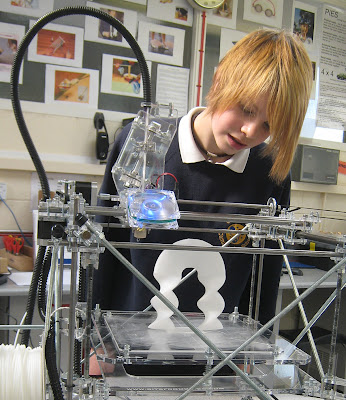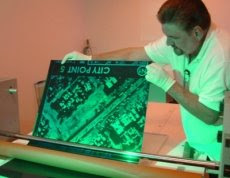 Schools and Colleges are already starting to teach Rapid Prototyping, but the technology is too costly to be accessible to everyone.. until now! For well under £1,000, you can create 3D shapes in a number of different materials.
The RapMan not only enables the teaching of RP and RM, but also is supplied in kit form, so building the RapMan contributes towards the teaching and learning of engineering.
Rap-Man
Schools and Colleges are already starting to teach Rapid Prototyping, but the technology is too costly to be accessible to everyone.. until now! For well under £1,000, you can create 3D shapes in a number of different materials.
The RapMan not only enables the teaching of RP and RM, but also is supplied in kit form, so building the RapMan contributes towards the teaching and learning of engineering.
Rap-Man
An exploration of the exciting field of 3D Printing and 3D Printers in the fab shop, at work, at home and in school.
Tuesday 26 May 2009
With more 3D printer 'kits' appearing, schools are also starting to print in 3D
 Schools and Colleges are already starting to teach Rapid Prototyping, but the technology is too costly to be accessible to everyone.. until now! For well under £1,000, you can create 3D shapes in a number of different materials.
The RapMan not only enables the teaching of RP and RM, but also is supplied in kit form, so building the RapMan contributes towards the teaching and learning of engineering.
Rap-Man
Schools and Colleges are already starting to teach Rapid Prototyping, but the technology is too costly to be accessible to everyone.. until now! For well under £1,000, you can create 3D shapes in a number of different materials.
The RapMan not only enables the teaching of RP and RM, but also is supplied in kit form, so building the RapMan contributes towards the teaching and learning of engineering.
Rap-Man
Thursday 21 May 2009
3D Print in Sugar? Yum!
 Now things are getting a bit crazy. The CandyFab project is using 3D printing techniques, to print with Sugar. Yes .. the edible crystalline substance, mainly sucrose, lactose, and fructose. It's testament to the simplicity of 3D printing that this is possible.
CandyFab Project
[snip] The goals of The CandyFab Project are to reduce the costs associated with three-dimensional solid freeform fabrication, and to promote the use of fabrication technologies for culinary, educational, and artistic purposes.
Now things are getting a bit crazy. The CandyFab project is using 3D printing techniques, to print with Sugar. Yes .. the edible crystalline substance, mainly sucrose, lactose, and fructose. It's testament to the simplicity of 3D printing that this is possible.
CandyFab Project
[snip] The goals of The CandyFab Project are to reduce the costs associated with three-dimensional solid freeform fabrication, and to promote the use of fabrication technologies for culinary, educational, and artistic purposes.
Thursday 14 May 2009
3D Printing from Holograms
 A company is bringing full-color, glasses-free holograms to life, and R2D2’s got nothing to do with it. Instead, Zebra Imaging creates true 3D objects through software and a fast, powerful printing machine.
[snip] ZI’s software places a virtual camera inside every point of a digital model’s holographic vertical plane, in order to record its surface volume. Zebra then prints the data (containing distinct POVs) to a plastic polymer, creating a sheet full of 1-mm holo tile encryptions. Each tile is basically an image data conductor sensitive to light. When light is shined, its energy scatters around and all image angles are revealed at once, popping up a free-standing 3D model. When you reach out to “touch” the 3D buildings in a demo, you feel nothing but air, revealing a true optical illusion.
This tech is important for a few reasons. The wide angles and true depth volume of the renders help people collaborate easier in real space, as opposed to a 2D screen (and might help avoid visual fatigue). And the 3D slabs are cheaper and faster to make than models made of other materials, like clay. This is why the U.S. Army likes them — maps of constantly changing battlefields can be printed on the fly.
From Three companies to watch in 3D
A company is bringing full-color, glasses-free holograms to life, and R2D2’s got nothing to do with it. Instead, Zebra Imaging creates true 3D objects through software and a fast, powerful printing machine.
[snip] ZI’s software places a virtual camera inside every point of a digital model’s holographic vertical plane, in order to record its surface volume. Zebra then prints the data (containing distinct POVs) to a plastic polymer, creating a sheet full of 1-mm holo tile encryptions. Each tile is basically an image data conductor sensitive to light. When light is shined, its energy scatters around and all image angles are revealed at once, popping up a free-standing 3D model. When you reach out to “touch” the 3D buildings in a demo, you feel nothing but air, revealing a true optical illusion.
This tech is important for a few reasons. The wide angles and true depth volume of the renders help people collaborate easier in real space, as opposed to a 2D screen (and might help avoid visual fatigue). And the 3D slabs are cheaper and faster to make than models made of other materials, like clay. This is why the U.S. Army likes them — maps of constantly changing battlefields can be printed on the fly.
From Three companies to watch in 3D
Alphabet Blocks
 Sometimes it's the little things that lead one to realize that 3D Printing is going to be wildly popular. Jordan Berger, New Paltz High School, New York, is a finalist in Dimension Printing's Extreme Redesign Contest competition.
[snip] This new redesigned alphabet block would also be more educational then the traditional block. Usually with blocks, the only language is English, children growing up with the new blocks may become global marketers, dealing in many different languages since the new block increases exposure to different languages. Also, the child's creativity is increased by seeing the drawing symbolizing the letter, formulating the link and eventually spelling. These blocks may aide the child in their education in the future, and as a result, be an integral part of their life.
Sometimes it's the little things that lead one to realize that 3D Printing is going to be wildly popular. Jordan Berger, New Paltz High School, New York, is a finalist in Dimension Printing's Extreme Redesign Contest competition.
[snip] This new redesigned alphabet block would also be more educational then the traditional block. Usually with blocks, the only language is English, children growing up with the new blocks may become global marketers, dealing in many different languages since the new block increases exposure to different languages. Also, the child's creativity is increased by seeing the drawing symbolizing the letter, formulating the link and eventually spelling. These blocks may aide the child in their education in the future, and as a result, be an integral part of their life.
Tuesday 5 May 2009
From Digital Life to Real Objects!
ProTocuBe uses the potential of 3D technology to make ideas real and to visualize projects. In particular, ProTocuBe uses various Rapid Prototyping technologies to make physical models, real-scale prototypes and scale models, for architecture, design and many different fields of application.
Rapid Prototyping is a series of systems able to create an object automatically, starting from a digital 3D model, in short times, without limits referring to the geometrical complexity, with a deep detail, in various materials, also coloured and textured.
Here is a video of a series of workshops led by ProTocuBe as they worked with students of 3D technologies.
Subscribe to:
Posts (Atom)